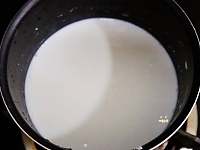中国年糕
Chinese rice cakes, or niangao, are made from pounded rice and have a sticky, chewy texture. Niangao’s origin story may date back to as many as 2,500 years ago to Suzhou during a chaoticperiod of war, which lasted from 722 to 481 BC.
中国年糕,是由捣碎的大米制成的,口感粘糯具有嚼劲。年糕的起源可以追溯到2500年前的苏州,当时正值公元前722年至481年的春秋战国时期。
The Wu Kingdom’s prime minister was first credited with shaping glutinous rice flour into bricklike shapes and saving his people from starvation when his kingdom was besieged.
吴国的宰相在吴国被围困之际,将糯米粉做成砖状,使人民免受挨饿,他被认为是第一个做年糕的人。

Niangao lore also tells of a Beijing custom that involveseating rice cakes on the first day of Lunar New Year back in the Liao dynasty. During the Ming and Qing Dynasties, niangao became a common staple, with different varieties developed in the north and south.
传说早在辽代,北京就有在农历新年的第一天吃年糕的习俗。在明清时期,年糕成为一种常见的主食,在北方和南方地区有了不同的种类。
One notable recipe found in southern China, particularly in Shanghai, involves stir-frying flat rice cakes with sliced pork, leafy greens and a sweet-savoury sauce consisting of soy sauce and sugar. While rice cakes can be eaten all year round, they are traditionally regarded as special dishes shared during Lunar New Year reunion meals, representing good luck and fortune as niangao is ahomonymfor “higher year”.
在中国南方,特别是在上海,有一个典型的烹饪方法,就是用猪肉片、蔬菜和甜酱来炒年糕。虽然年糕一年四季都可以吃,但从传统上来说,年糕是农历新年团圆饭的特色菜肴,代表着好运和财富,因为年糕谐音“年高”。
韩国年糕
Meanwhile, literallytranslated as “stir-fried rice cake”, tteokbokki is a popular Korean street food that is made with small-sized garaetteok. Unlike the Chinese version that is sliced and flat, garaetteok is a long and cylindrically-shaped tteok, or rice cake, and has a significantly chewier bite than its Chinese counterpart.
同时,Tteokbokki的直译是“炒年糕”,他是一种流行的韩国街头食品,用小年糕棒(garaetteok)制作而成。与中国片状、扁平的年糕不同,年糕棒是一种长圆柱形的韩国年糕(teok),而且咀嚼起来明显比中国的年糕更有嚼劲。
The first references to tteok appeared in several books about wars between China and Korea that took place between 480 and 222BC. The books told of washed rice that was pounded into a powder and mixed with water, before being shaped into flat discs that were steamed.
在记录 公元前480年至公元前222年间发生的中韩战争的书籍中首次提到了韩国年糕。这些书中讲到,洗净的大米被捣成粉并与水混合,然后将其做成平盘状蒸熟。

To draw focus on the rice cakes’ chewy texture, tteokbokki is served with minimal garnish and side ingredients. The rice cakes are boiled and coated in a red sauce of gochujang (chilli paste), gochugaru (red pepper flakes), soy sauce, sugar and sesame seeds. Some home-made recipes include sliced eomuk (flat fish cake), cabbage and scallions.
为了使人们关注年糕耐嚼的口感,韩国炒年糕会尽量少加配菜和配料。年糕煮熟后涂上由辣椒酱、红辣椒片、酱油、糖和芝麻做成的红色调味酱。一些自制的食谱中还会放一些切片的鳗鱼(鱼饼)、卷心菜和葱。
Key points:
1、混乱的: chaotic
到了17岁,我一心渴望脱离这既混乱又舒适的营地。
2、包含;涉及: involve
Where there have been delays in the final outcome, geological processes involve thousands of factors, so precision is not always possible.
最终的结果出现延迟,地质过程包含成千上万种影响因素,所以不可能永远精确。
3、主食:staple
By July, Indica rice prices, the staple for the majority of the population, were about the same level than a year ago.
截至七月,籼米价格,主食为多数的人口,大约相同的水平比去年同期水平。
4、同音异意:homonym
Different dialects have different speech characteristics, creating a homonym of different customs.
不同的方言有不同的语音特点,因而形成了各地不同的谐音习俗。
5、字面上:literally
But he did not mean literally to see with your eyes.
但是这里的“看见”不是字面的意思。
CATTI口译/笔译课程
提升你的双语翻译能力
免费领取CATTI学习干货

CATTI备考资料,
专属学习方案
免费领取
☟☟☟
更多免费好课
点击【阅读原文】立刻领取
免责声明:本文仅代表文章作者的个人观点,与本站无关。其原创性、真实性以及文中陈述文字和内容未经本站证实,对本文以及其中全部或者部分内容文字的真实性、完整性和原创性本站不作任何保证或承诺,请读者仅作参考,并自行核实相关内容。
举报邮箱:3220065589@qq.com,如涉及版权问题,请联系。












网友评论